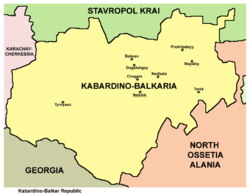History of Kabardino-Balkaria
The Republic of Kabardino-Balkaria is a federal subject of Russia (a republic), located in the Caucasus region.
Early history
As with other parts of the Caucasus, the area that is now known as Kabardino-Balkaria has been inhabited for thousands of years. The origins of its inhabitants are somewhat obscure.
It is known that proto-Kabardians called Kassogs were inhabiting that area already in the 9th century, as the Arab traveler Al Masudi speaks of them. Balkars were part of Alania and one of the Vainakh tribes, who were influenced by Turkic culture after the Mongol invasion's split of the lowlands of Nakh tribes and adopted the language. Also genetically they are closely related to Chechens and Ingush.[1]
The region came under the control of the Mongols between 1242–1295. It passed into the hands of the Georgians from 1295 to 1505 before falling, briefly, into the orbit of the Persian Empire between 1502–1516. It was then ruled by the Ottoman Empire from 1516–1557. From 1557, it became a protectorate of the expanding Russian state – first Muscovy, then the Russian Empire. See Kabardia.
Russian and Soviet rule
Kabardia gained independence briefly between 1739–1774, before being annexed by Russia under the terms of the Treaty of Küçük Kaynarca. Balkaria was annexed in 1827. The Russians established a number of forts in the region, notably at Nalchik (the republic's present-day capital), to secure their control over it. A significant number of Russians – many of Cossack descent – also settled there.
During the Russian Civil War, the region became part of the anti-communist South-Eastern League (1917–1918), then joined the Mountain Peoples’ Autonomous Republic in 1921. On September 1, 1921, with the emergence of the Soviet Union, the territories were organized into the Kabardin Autonomous Oblast. The region's name was changed to the Kabardino-Balkar Autonomous Oblast the following year, and on December 5, 1936 it was elevated in status and named Kabardino-Balkar Autonomous Soviet Socialist Republic.
In 1944, Soviet leader Joseph Stalin falsely accused the Balkars of collaborating with Nazi Germany and deported the entire population. Their name was deleted from the territory, which was renamed the Kabardin ASSR. The Balkar population was only allowed to return in 1957 at which point its pre-war name was restored.
Post-Soviet history

Kabardino-Balkaria became a full republic in 1991 and in March 1992 became one of the constituent republics of the Russian Federation.
The republic's economy was very hard hit by the fall of the Soviet Union and the outbreak of war in neighboring Georgia and nearby Chechnya. The instability produced by the conflicts led to a collapse in tourism in the region and produced an unemployment level estimated to be as high as 90%. The republic's mainly Muslim population has become increasingly radicalised by the region's instability. In October 2005, Kabardino-Balkaria's capital Nalchik was the site of fighting after an attack on the city by Chechen militants. On 1 July 1994 Kabardino-Balkaria became the second republic after Tatarstan to sign a power-sharing agreement with the federal government, granting it autonomy.[2] This agreement would be abolished on 8 August 2002.[3]
References
- "Archived copy". Archived from the original on 2013-12-03. Retrieved 2013-08-12.CS1 maint: archived copy as title (link)
- Solnick, Steven (29 May 1996). "Asymmetries in Russian Federation Bargaining" (PDF). The National Council for Soviet and East European Research: 12.
- Chuman, Mizuki. "The Rise and Fall of Power-Sharing Treaties Between Center and Regions in Post-Soviet Russia" (PDF). Demokratizatsiya: 146.